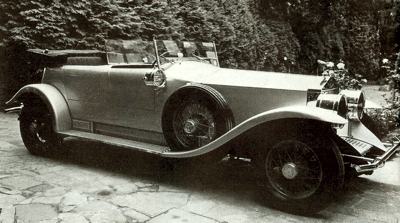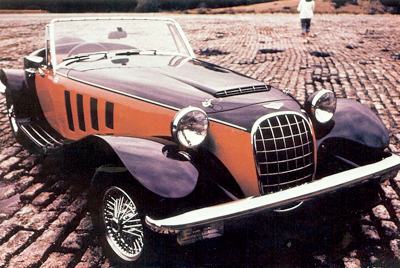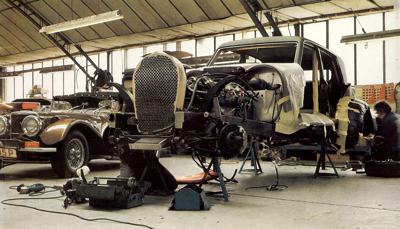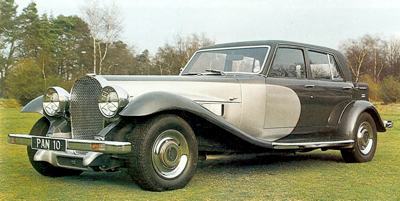Robert Jankel
Robert Jankel started out working with John Young, boss of Superspeed, and while there he gained some notable success on the race track. As an engineer, he was able to design and build his own cars, using various different styles, ranging from vintage to futuristic. Unfortunately, Bob Jankel found that there was not enough money to be made in the tuning business and he left John Young to enter a new field: the fashion industry.
He became Merchandising Director, with a considerable number of shares, of quite a large company, but he did not let this deter him from continuing his hobby and he carried on building cars on a regular basis (about one a year). During this period, friends asked for replicas, and this led to Jankel selling his shares and setting up Panther as a company in 1971.
The Panther J72
Initially, the concern was based in the garage belonging to Bob Jankel's Walton-on- Thames home, the office being in the house. The
prototype Panther was an elegant vintage-style four-seat tourer, which owed more than a little of its frontal shape to the Rolls-Royce company. It took only a few months for this
prototype to be developed into the first 'production' model, known as the
J72 and announced in June 1972. This car was typical of every car to come subsequently from Panther, in having a hand-made aluminium body, which was trimmed in
Connolly leather and gleaming walnut, coated with a massively thick and deeply shiny paint finish and mounted on a sturdy box-section chassis.
The engine for the J72, in its original form, was the Jaguar 3.8-litre XK straight six, and beam axles were fitted front and rear, suspended on coil-spring/damper units. Although not advertised as such, the J72 was built in the image of the SS100 made in the 1930s. Soon after the J72'S introduction, a tuned version, known as the J72S, was launched. Externally, the only difference was that this model had
alloy wheels in place of the chrome wire units fitted to be standard car, but the engine produced considerably more power.
At this time, a great deal of the work of building Panthers was being done by outside contractors, but interest in the cars was keen enough to warrant a move to larger premises. Consequently, the company moved to the old Cooper Car Company factory at Byfleet, near Weybridge, in Surrey; in the process, Robert jankel acquired several of the original contractors and incorporated them into the corporate structure. Panther West Winds became responsible for assembly, Panther Shapecraft for the coachwork, Panther Spray craft for the paintwork, Panther Screencraft for the screen frames, Panther Spincraft for metal spinnings such as hub caps and headlamp bowls and Panther Trimcraft for the upholstery and trim work.
Several of these subsidiary companies were also performing high-quality work for other companies, including Rolls-Royce, and Panther also offered a design service, all car-design work for the company being executed by Robert Jankel himself. In 1973, Panther announced two new versions of the J72, powered by either the 4.2-litre XK engine or the new 5.3-litre Jaguar V12. Needless to say, the V12 unit gave the car electrifying performance, although it added about two thousand pounds to the £7500 of the 4.2. Unfortunately, Panther were unable to obtain complete V12s from Jaguar, so they bought sets of 'spare' parts and then assembled the engines themselves. It was not long before the company came to more convenient arrangement with Jaguar and purchased complete units. In 1975, however, the V12 was dropped.
 The very first Panther was a 4 seater tourer, based somewhat on vintage Rolls-Royce style.
The very first Panther was a 4 seater tourer, based somewhat on vintage Rolls-Royce style.
 The Panther Lima used Vauxhall Magnum running gear, including the torquey 2300cc OHC four.
The Panther Lima used Vauxhall Magnum running gear, including the torquey 2300cc OHC four.
 Panther De Ville being assembled and the Panther-Westwinds factory.
Panther De Ville being assembled and the Panther-Westwinds factory.
 A completed Panther De Ville, which used Jaguar running gear and was styled on the Bugatti Royale. At the time, the De Ville was one of the most expensive cars in the world.
A completed Panther De Ville, which used Jaguar running gear and was styled on the Bugatti Royale. At the time, the De Ville was one of the most expensive cars in the world. |
The Panther Ferrari FF
Minor modifications were made to other parts of the cars when the engine options were changed: for instance, the side-screens and dashboard were redesigned and the suspension was relocated for greater comfort. During the first year of J72 production cars were built for use in nine countries, and this encouraged Bob Jankel to introduce more new models, starting with the Panther Ferrari FF, first seen at the Geneva Show in March 1974. The FF was based on the chassis and running gear of the Ferrari 330GTC and clothed in a beautiful aluminium body reminiscent of the 1947 Ferrari 125s. As with the J72, the interior was sumptuously trimmed in Wilton carpet,
Connolly hide and burr walnut. Remarkably, the design, development and construction of the car were carried out in only three months, plenty of midnight oil being burnt during this period. It was not unusual for the lights of the assembly section to be on all night whenever a car was wanted urgently.
The Panther Lazer
With their next model, Panther jumped into the future, with a high-class beach buggy known as the Lazer. Announced in July 1974, the Lazer was fitted with the Jaguar V12 engine, giving a top speed of more than 150 mph in the wedge shaped aluminium body. Running gear was also Jaguar and the three-seat-abreast interior was trimmed to the usual high standards. A straight six was offered as an option, but the Lazer was a departure from Panther's more usual style and never became a 'production' model. Hot on the heels of the Lazer, in time for the Earl's Court Motor Show in October, came what was one of the most expensive cars in the world. With a basic price at the time of UK£17,650, the De Ville was a real luxury limousine based on the elegant and beautiful lines of the Bugatti Royale, a legendary but disastrous car of the early 1930s.
The Panther De Ville
Once again, a Jaguar engine (V12) and Jaguar running gear were mounted on a box-section chassis and covered by a hand-made aluminium body. Unlike the Bugatti, the De Ville had independent suspension all round, together with power-assisted disc
brakes and wide
tyres for safety, while inside electric windows and
air-conditioning were standard fittings. The list of optional extras for the De Ville was almost endless, each car, as with other Panther models, being made to 'fit' its prospective owner.- Despite the vintage quality of the De Ville and the J72, both were capable of passing the statutory 30 mph crash test, having energy absorbers built into the chassis members where the functional bumper bars were affixed (front only on the J72). In fact, when the J72 was crash tested, it emerged with very little damage.
The Panther Rio
In 1975, Panther unveiled the Rio, a model which marked something of a departure from the design and manufacture of replicas. A compact, quality saloon based on Triumph Dolomite running-gear and using' either the standard 1850cc Dolomite unit or the more powerful z-Iitre, rti-valve Dolomite Sprint engine, it was intended purely as an up-market saloon car of the seventies with a body and interior of Panther's own design. As with other Panther models, there was no fixed price. During 1975, Panther West Winds had various pro-projects on the drawing board, and had even built a Lancia-based version of the Ferrari FF. However, Panther production and design was not concentrated on motoring; the company would undertake any project and see it through from rough sketch to top-quality finished article.
The Panther Lima
In 1976, Panther launched perhaps their most significant car: the Lima. The Lima was very much a 'bargain-basement' Panther using cheap and plentiful Vauxhall Magnum parts and selling for under £5000 from selected Vauxhall dealers. Late 1977 saw the launch of Panther's most outrageous car to date. Weighing-in at a staggering £39,950, the Panther 6 (6 referring to the number of wheels) was claimed to be the world's fastest car, and with an 8-litre mid-mounted Cadiliac V8 toting twin turbochargers and developing 600 bhp. Within six months, Panther claimed to have sold no less than fifteen examples, and that was without even touching the American market.
The six wheel configuration was inspired by the Tyrrell P34. The layout was one pair of rear wheels with 265/50 VR16
tyres and two pairs of steerable front wheels with 205/40 VR13 tyres. The specification included a detachable hard top and convertible soft top, electronic instruments,
air-conditioning, an automatic fire extinguisher, electric seats and windows, a telephone and a television set. Claims for the top speed of this vehicle suggested it was capable of over 200 mph (322 km/h); however, these claims are so far unsubstantiated.
But finding enough customers with deep pockets was always a task Panther struggled with, and in hindsight perhaps the desire to build the ultimate road-going cars was not such a good idea. Panther-Westwinds eventually collapsed in 1980 and was purchased by Young Kim of Korea. He built a new British factory in Harlow, Essex, and began assembling cars using Korean-made bodies. In the 1980s the company moved into the sports car arena, culminating with the 1990 Panther Solo. Panther lost money on every Solo, and the company was liquidated, with assets going to the Korean SsangYong Motor Company shortly afterwards.



